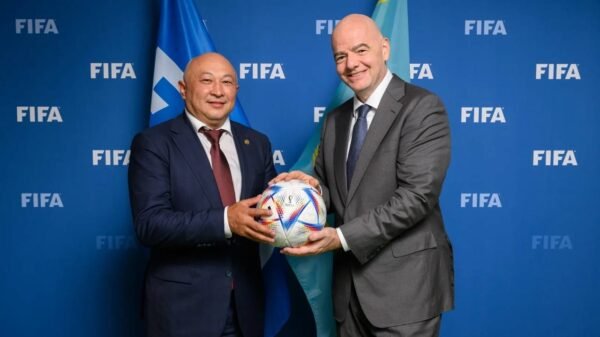
As the game progressed, the Cubs faced an unexpected setback when Justin Steele, their highly anticipated opening day starter, suffered a debilitating hamstring injury. The incident took place during a crucial moment in the game when the opposing team attempted a bunt. With lightning-fast reflexes, Steele sprinted towards the ball, determined to make the play. However, as he lunged forward to grab the ball and throw it to first base, he felt a sharp pain shoot up his leg.
The fans in the stadium held their breath as Steele crumpled to the ground, clutching his injured hamstring. The team’s medical staff rushed to his side, assessing the severity of the injury. It was clear that Steele would not be able to continue playing, and he was immediately helped off the field, his disappointment evident on his face.
The loss of Steele on opening day was a significant blow to the Cubs, who were relying on his strong pitching performance to set the tone for the season. The young left-hander had shown immense promise during spring training, displaying excellent command of his pitches and a composed demeanor on the mound. The team had high hopes that he would be a key contributor to their starting rotation.
Steele’s injury not only left a void in the Cubs’ pitching rotation but also raised concerns about the overall depth of their pitching staff. With the loss of their opening day starter, the team would need to rely on their bullpen and potentially make adjustments to their pitching strategy moving forward.
The Cubs’ coaching staff immediately went into action, huddling together to discuss the best course of action. They knew they needed to find a temporary replacement for Steele and make adjustments to ensure the team’s success in the upcoming games.
Meanwhile, Steele underwent further evaluation to determine the extent of his injury. The team’s medical staff worked tirelessly to develop a personalized rehabilitation plan that would expedite his recovery and get him back on the mound as soon as possible. It was a race against time to heal his hamstring and regain his strength and mobility.
As news of Steele’s injury spread, fans and analysts alike speculated on the impact it would have on the Cubs’ season. Some worried that his absence would be a significant setback, while others remained hopeful that the team would rally together and overcome this obstacle.
Only time would tell how the Cubs would fare without their opening day starter. In the meantime, the team would need to regroup, adjust their game plan, and find a way to fill the void left by Justin Steele’s untimely injury.
The impact of Justin Steele’s injury goes beyond just the immediate concern of finding a replacement for the pitching rotation. It also raises questions about the team’s overall depth and ability to withstand injuries throughout the season. The Cubs had hoped that Steele would be a key contributor to their pitching staff, but his early exit has forced them to reassess their options.
One of the main concerns for the Cubs is the lack of experienced pitchers in their farm system. While they have some promising young arms, the team may now need to consider bringing in outside help to bolster their rotation. This could mean exploring potential trades or signing free agents who are still available.
Furthermore, Steele’s injury highlights the importance of having a strong bullpen. With a reliable bullpen, the Cubs can minimize the impact of injuries to their starting pitchers. However, if their relievers are already overworked or struggling to perform consistently, the loss of Steele could expose a significant weakness in the team’s pitching staff.
Another factor to consider is the psychological impact of Steele’s injury on the rest of the team. Losing a key player early in the season can be demoralizing, and it will be important for the Cubs’ coaching staff to keep the team focused and motivated. They will need to rally around each other and find ways to compensate for the absence of Steele.
In the long term, the Cubs may need to reevaluate their approach to player conditioning and injury prevention. It is crucial for the team to have a comprehensive plan in place to minimize the risk of injuries and ensure that their players are in peak physical condition. This could involve working closely with trainers and medical staff to develop personalized training programs for each player.
Overall, Justin Steele’s injury has had a significant impact on the Chicago Cubs. It has exposed weaknesses in their pitching rotation, highlighted the need for a strong bullpen, and raised questions about the team’s depth and ability to withstand injuries. Moving forward, the Cubs will need to make adjustments and find ways to overcome these challenges if they hope to remain competitive throughout the season.
One pitcher who has been a source of concern for the Cubs is Kyle Hendricks. While he has had moments of brilliance in the past, he has struggled to find his form this season. His usually pinpoint control has been off, resulting in an increase in walks and hits allowed. This has led to inflated earned run averages and shorter outings, putting additional strain on the bullpen.
Another pitcher who has been inconsistent is Jake Arrieta. After returning to the Cubs this season, there were high hopes that he would regain his previous form. However, he has struggled to find consistency on the mound. His velocity has dipped, and his command has been erratic. As a result, he has had trouble getting deep into games and has been prone to giving up big innings.
The Cubs have also had to deal with injuries to their bullpen. Closer Craig Kimbrel has been sidelined with a minor ailment, forcing the team to rely on other relievers to close out games. While the bullpen has been relatively solid, the absence of Kimbrel has been felt, especially in tight games.
Overall, the Cubs’ pitching rotation concerns have been a major factor in their struggles this season. Injuries, inconsistencies, and a lack of depth have all contributed to their pitching woes. As the season progresses, it will be crucial for the Cubs to address these issues and find ways to stabilize their rotation. Whether through internal solutions or external acquisitions, the Cubs must find a way to improve their pitching if they hope to compete in a highly competitive division.
The Cubs’ Plan Moving Forward
Despite the setback of Justin Steele’s injury, the Chicago Cubs will need to regroup and develop a plan to address their pitching rotation concerns. The team’s coaching staff and front office will likely assess the available options and make decisions based on the best interests of the team.
One possible solution for the Cubs is to rely on their farm system and give opportunities to promising young pitchers. This approach would not only provide valuable experience for these pitchers but also allow the team to evaluate their potential for the future. While it may come with some growing pains, investing in the development of young talent could pay off in the long run.
Another option for the Cubs is to explore trade possibilities to acquire additional pitching depth. This would require the team to assess their trade assets and identify potential trade partners. While making a trade can be a complex process, it could provide the Cubs with immediate help to stabilize their rotation and address their pitching concerns.
Regardless of the path the Cubs choose, it is crucial for them to prioritize the health and well-being of their pitchers. Taking a cautious approach to injuries and ensuring proper rest and rehabilitation will be essential in preventing further setbacks and maintaining the long-term effectiveness of their pitching staff.
In addition to developing their young pitchers and exploring trade options, the Cubs could also consider signing free agents to bolster their rotation. This would require the team to evaluate the available free agent market and identify pitchers who could fit well with their team and pitching philosophy. While signing free agents can come with financial implications, it could provide the Cubs with experienced pitchers who can contribute immediately.
Furthermore, the Cubs may also need to focus on improving their pitching development program. This could involve hiring additional coaches or implementing new training techniques to help their pitchers reach their full potential. By investing in their development program, the Cubs can ensure that their pitchers are equipped with the necessary skills and knowledge to succeed at the major league level.
Lastly, the Cubs should also consider the long-term sustainability of their pitching staff. This means not only focusing on the present needs but also planning for the future. By identifying and developing young pitchers who have the potential to become future aces, the Cubs can ensure that they have a strong and reliable rotation for years to come.



































